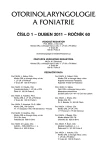Dytrych P., Katra R., Jurovčík M., Karmanová D., Šnajdauf J., Kabelka Z.: Laryngotracheoesophageal Cleft
Authors:
P. Dytrych 1
; R. Katra 1; M. Jurovčík 1; D. Karmanová 2; J. Šnajdauf 3; Z. Kabelka 1
Authors‘ workplace:
Klinika ušní, nosní a krční 2. LF UK a FN v Motole, Praha, přednosta doc. MUDr. Z. Kabelka, Ph. D.
1; Klinika anesteziologie a resuscitace 2. LF UK a FN v Motole, Praha, přednosta prof. MUDr. K. Cvachovec, CSc., MBA
2; Klinika dětské chirurgie 2. LF UK a FN v Motole, Praha, přednosta prof. MUDr. J. Šnajdauf, DrSc.
3
Published in:
Otorinolaryngol Foniatr, 60, 2011, No. 1, pp. 8-11.
Category:
Original Article
Overview
Laryngotracheoesophageal cleft (LTEC) is a rare inborn anomaly, where the respiratory and swallowing pathways are not separated and in the middle line there is a defect of different extent in the area of posterior wall of larynx, trachea and anterior wall of pharynx and esophagus. The aim of surgical intervention is to divide aerodigestive compartments into two functional tracts without the need of dependence on tracheostomy, with the possibility of phonation and prevention of swallowing difficulties. In the period of 1999-2009 the authors operated on four children with LTER of the type III classification according to Benjamin and Iglis at the Ear, Nose and Neck Clinic, 2nd Medical Faculty, Charles University and Teaching Hospital Motol in collaboration with the Clinic of Child Surgery of the same location. In most cases the authors selected the external anterior cervical approach with interposition of the graft. In the postoperative period the authors encountered complications in one patient, specifically the respiratory insufficiency caused by tracheomalacia. A successful therapy of LTER depends on early diagnosis, prevention of aspiration and gastroesophageal reflux, adequate nutrition and a timely surgical intervention.
Key words:
laryngotracheoesophageal cleft, endoscopy, anterior cervical approach
Sources
1. Alabdulgader A., Patten D.: Laryngotracheoesofageal cleft type 3 and double outlet right venticle: unique combination. Annals of Diagnostic Pathology, 2005, 9, s. 323-326.
2. Antao, B., Soccorso, G.: H-type tracheosophageal fistula with type III laryngotracheoesofageal cleft. Eur Arch. Otorhinolaryngol, 264, 2007, s. 1373-1376.
3. Carr, M. M, Clarke, K. D.: Congenital laryngotracheoesophageal cleft. The Journal of Otolaryngology, 28, 1999, 2.
4. Delank, K. W., Stoll, W.: Congenital laryngotracheo- esofageal cleft: diagnosis and surgical treatment by anterior, translaryngeal approach. Laryngorhinootolgie, 78, 1999, 7, s. 401-404.
5. Dietz, H. G: Type IV Laryngotracheoesophageal cleft associated with microgastria and left lung hypoplasia: Report of a long-term survivor. Eur J. Pediatr. Surg., 19, 2009, s. 120-121.
6. Garabedian, E. N., Ducroz, V.: Posterior laryngeal clefts: preliminary report of a new surgical procedure using tibial periostem as an interposition graft, Laryngoscope, 108, 1998, s. 899-902.
7. Geller, K., Kim, Y.: Surgical management of type III and IV laryngotracheoesofageal clefts: the treee layer approach. International Journal of Pediatric Otorhinolaryngology, 74, 2010, s. 652-657.
8. Jackson, J. R., Viayasekaran, S.: Exomphalos and Type IV laryngeal cleft: A surgical challenge. Eur J. Pediatr. Surg., 19, 2009, s. 124-125.
9. Kawaguchi, A., Donahoe, P. K.: Management and long-term follow-up of patients with types III and IV laryngotracheoesophageal clefts. Journal of Pediatric Surgery, 40, 2005, s. 158-165.
10. Kennedy, C. A., Heimbach, M.: Diagnosis and determinativ of the clinical signifikance of type Ia laryngeal clefts by gelfoam ijnection. Ann. Otol. Rhinol. Laryngol., 109, 2000, s. 991-995.
11. Kubba, H., Gilbson, D.: Techniques and outcomes of laryngeal cleft repair: an update to the Great Ormond Street Hospital Series. Ann. Otol. Rhinol. Laryngol., 114, 2005, s. 309-313.
12. Mathur, N., Peek, G. J.: Strategies for managing type IV laryngotracheoesofageal clefts at Great Ormond Street hospital for Children. International Journal of Pediatric Otorhinolaryngology, 70, 2006, s. 1901-1910.
13. Nicollas, R., Sudre-Levillain, I.: Surgical repair of laryngotracheoesofageal clefts by tracheoesophagoplasty with two overlapping flaps. Annals of Otology, Rhinology and Laryngology, 115, 5, s. 346-349.
14. Roth, B., Rose, K. G.: Laryngotracheoesophageal cleft. Eur J. Pediatr., 140, 1983, s. 41-46.
15. Sandu, K., Monnier, P: Endoscopic laryngotracheal cleft repair without tracheotomy or intubation. Laryngoscope, 16, 2006, s. 630-634.
16. Simpson, B. B., Ryan, D. P.: Type IV laryngotracheoesophageal clefts: surgical management for long-term survival. J. Pediatr. Surg., 31, 1996, s. 1128-1133.
17. Šnajdauf, J., Škába, R.: Dětská chirurgie. Galén, 2005, s. 158-159.
18. http://www.nature.com/gimo/contents/pt1/fig_tab/gimo36_F1.html (McCulloch T. M., Jaffe D.)
Labels
Audiology Paediatric ENT ENT (Otorhinolaryngology)Article was published in
Otorhinolaryngology and Phoniatrics

2011 Issue 1
Most read in this issue
- Lipový B., Řihová H., Kaloudová Y., Jonášek M., Suchánek I., Gregorová N., Brychta P.: Inhalation Trauma – History, Present and Future
- Krempaská S., Kovaľ J. : Complications after Eardrum Membrane Reconstruction
- Dytrych P., Katra R., Jurovčík M., Karmanová D., Šnajdauf J., Kabelka Z.: Laryngotracheoesophageal Cleft
- Hajtmanová E., Hajtman A., Kinclová I., Muríň P., Lietava P., Hajtman A., Péč M.: Percutaneous Endoscopic Gastrostomy in the Therapy of Patients with Advanced Head and Neck Tumors
